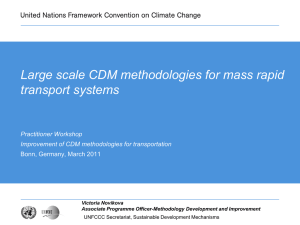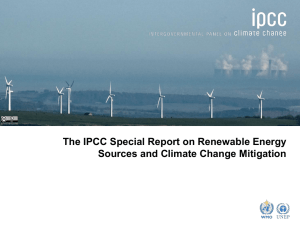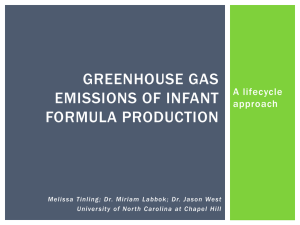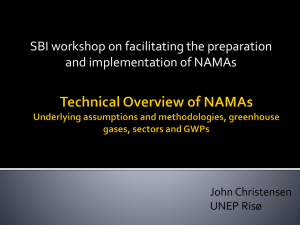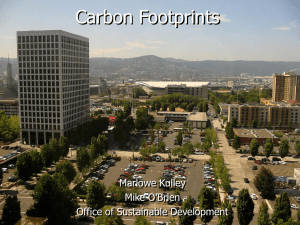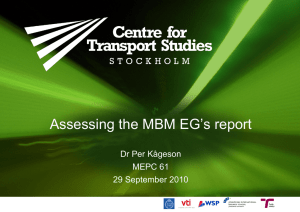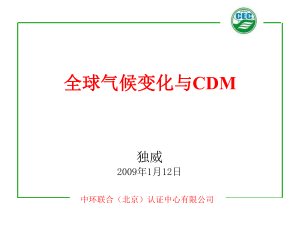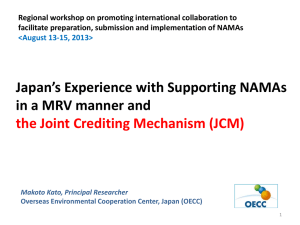Presentation by TERI
advertisement
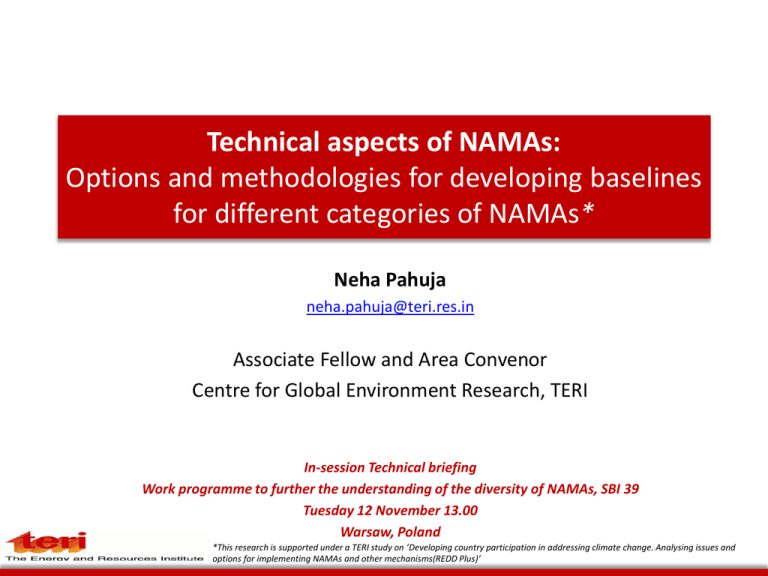
Technical aspects of NAMAs: Options and methodologies for developing baselines for different categories of NAMAs* Neha Pahuja neha.pahuja@teri.res.in Associate Fellow and Area Convenor Centre for Global Environment Research, TERI In-session Technical briefing Work programme to further the understanding of the diversity of NAMAs, SBI 39 Tuesday 12 November 13.00 Warsaw, Poland *This research is supported under a TERI study on ‘Developing country participation in addressing climate change. Analysing issues and options for implementing NAMAs and other mechanisms(REDD Plus)’ Various Categories of NAMAs (by scope: considering scale, type of activity, sector coverage) Category 1: Specific project activities – – – Category 2: Capacity building programmes – – – Various policies and actions plans in a specific sector or group of sector With or Without an overall sectoral mitigation goal Eg. national program on energy efficiency and renewable energy; or group of activities in agriculture sector; X% renewable electricity by X(year) Category 4: Economy-wide mitigation goal – – – Large scale preparatory programmes Various (group of) activities targeted towards readiness or capacity building Eg. promote the use of low-energy light bulbs; or preparation of national inventory Category 3: Sectoral programmes – – – Small scale activities with specific interventions Comparable to CDM projects Eg. upgrading of X,Y, Z hydroelectric dams; installation of mini-hydroelectric plants with a capacity of Z MW/unit amounting to a total of #% MW by X(year) With reference to BAU scenario or a reference year With or without a listing of specific activities, plans or programmes Eg. reduction in emissions / emissions intensity by X% below X(year) levels by X(year); or reduction in emissions / emissions intensity… by X% as compared to BAU by X(year); or to be carbon neutral by X(year) Category 5: Combination of any two categories – Eg. Reduction in emissions by X% as compared to BAU by X(year) through group of activities in forestry sector Not all NAMAs will lead to absolute emissions reductions and/or challengings to quantify GHG impact (reductions or deviations) Each category is unique; requires different approach for developing baselines Why do we need a baseline? Baselines may be useful – For developing countries to understand their own emissions (present & future) and prepare development plans accordingly – For developing countries to avail support (finance, technology, capacity building) as it would facilitate measuring of emission reductions/deviations – For aggregating emission reductions/deviations achieved across countries thereby reducing uncertainty in global emissions estimate However, – There is currently no international guidance on how to develop emissions baseline / or determine baseline emissions scenarios Developing guidelines for baseline determination Key Challenges: – Different categories of mitigation actions (by scope: considering scale, type of activity, sector coverage) – Direct attribution of GHG emissions reduction to specific mitigation action seems difficult – Not all NAMAs will lead to absolute emissions reductions – It is challenging to quantify GHG impact (reductions or deviations) in many cases (more difficult with higher level of aggregation) – Each NAMA unique therefore one size fits all approach may not work Key Considerations: – Increase in precision may involve increase in complexity leading to increase in transaction cost – Should takes into account relevant national and/or sectoral policies and circumstances – Should ensure flexibility and simplicity in approach – May need combination of different approaches Approach 1: CDM plus approach Using existing CDM baseline methodologies – The baseline for a CDM project activity is defined in 3/CMP.1, Annex, paragraph 44 as follows: » The baseline for a CDM project activity is the scenario that reasonably represents the anthropogenic emissions by sources of greenhouse gases that would occur in the absence of the proposed project activity (3/CMP.1, Annex, paragraph 44) – However, even in case of CDM projects, the process was considered cumbersome (new developments: standardized baselines) Applicable where NAMAs are listed as – Specific projects (Category 1) – Mitigation goals with list of specific projects contributing towards achieving the overall mitigation goal (Category 5) Approach 2: Baseline metrics approach Baseline Metrics – Baseline metrics to comprise of a set of indicators (observed in a reference year and measurable in coming years) – Tracking the indicators overtime indicates the progress and helps to estimate impact on GHG emissions – Flexibility in the choice of indicators of baseline metrics Applicable where NAMAs are listed as – Capacity building programmes (Category 2) – Mitigation goals in a sector or economy-wide (Category 3,4,5) – Specific project activities (Category 1) Baseline metrics approach Baseline metrics Indicator Indicator indicators: 1 Such as, GHG Emissions, share Reference of RE in electricity … Year (2005) mix, Emissions intensity, etc Year (2015) … Target Year (2020) ... Reference Year (eg. 2005) Indicator 2 … … ... GHG Impact Indicator 1 … Indicator 2 … Baseline metrics to comprise of set of indicators (observed in a reference year and measurable in coming years) Progress may be used to estimate impact on GHG emissions … Target Year (eg. 2020) Time Appropriate since not all NAMAs will result in absolute emissions reduction Approach 3: GHG Inventory Approach GHG emissions inventory as a baseline for absolute reductions – comparison of reference year inventory with target year inventory – actions are not measured but the result (GHG emissions reductions) – existing experience of preparing inventories for NATCOMs for NA1 Applicable where NAMAs are listed as – Economy-wide targets such as carbon neutrality (Category 4) – Sectoral plans with number of specific actions and policies (Category 3) – Combination of two (Category 5) Approach 4: Reference case approach Defining a reference case – According to IPCC AR 4, “business-as-usual” baseline/reference case assumes that future development trends follow those of the past and no changes in policies will take place – Impact on GHG emissions is equivalent to deviations from the reference case – Defining reference case projecting a probable emission trajectory by selecting an appropriate model for economy (set of policies and barriers; set of assumptions for future development and growth) Applicable where NAMAs are listed as – Economy-wide targets or sectoral plans as compared to a BAU scenario (Category 3,4,5) Reference case approach GHG Emissions Reference case Emissions deviations as a result of mitigation action Project activity or efficient case Time Hypothetical Example of a NAMA in Transport sector Overall goal: Development of a low carbon urban transport system Specific activities: 1. 2. 3. 4. 5. 6. Development of efficient public modes of transport like BRTS Development of infrastructure for Nonmotorised vehicles Change in Fuel use: electric vehicles, natural gas, biofuel Switching to efficient technology for motorised vehicles Retrofitting XYZ rail system with more efficient XYZ technology Conducting awarenessraising campaigns to promote low carbon urban transport Key Characteristics: – Overall sectoral goal: directional and nonquantifiable – List of specific policies, programs and projects (mix of directional, quantifiable) contribute to the overall sectoral goal – Many activities lead to indirect GHG benefits, sectoral GHG inventory might not be suitable – Combinational of approaches could be used – Baseline metrics approach for activity 1,2,3,4,6 » %age of urban population using BRTS/NMV for work trips » Current foot fall in existing city rail system/BRTS » Fuel mix composition » Qualitative: policy for technology standards for MVs – CDM plus approach for 5 Summary Approaches Approach 1: CDM plus approach Categories Category 1 (specific project activity) √ Category 2 Category 3 (Sectoral programs) Category 4 (Economy-wide mitigation goal) (combination of any two categories) Approach 3: Approach 4: GHG Inventory Reference Approach case approach √ √ (capacity building programs) Category 5 Approach 2: Baseline metrics approach √ √ √ √ √ √ √ √ √ √

